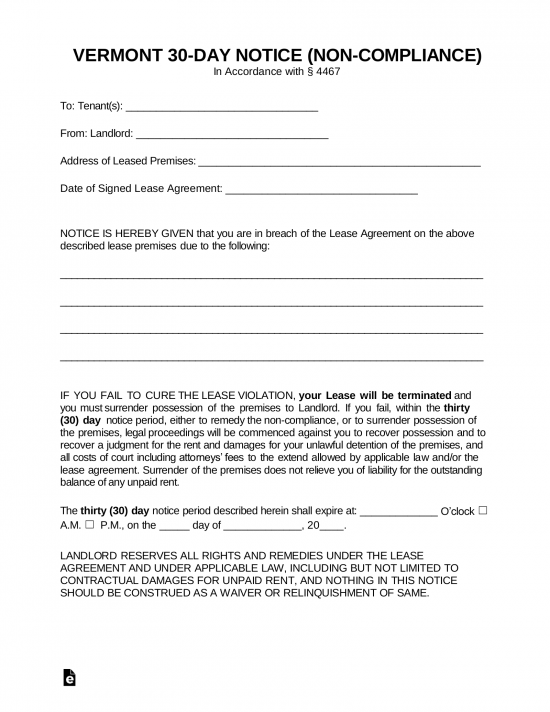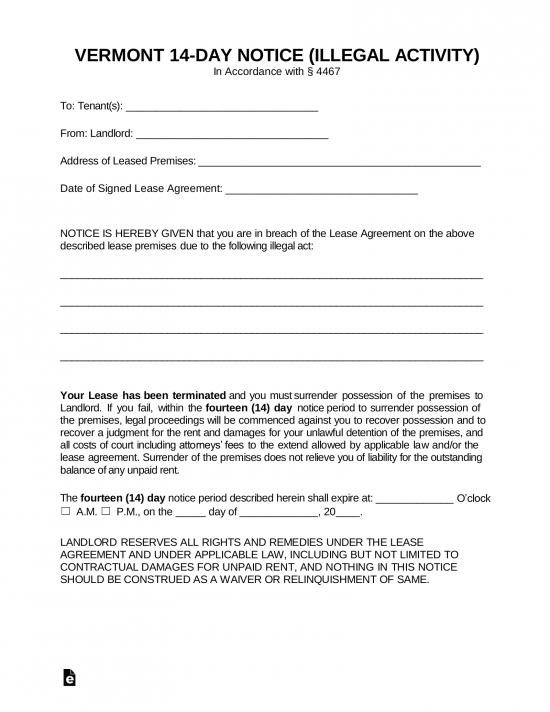Updated April 05, 2024
A Vermont eviction notice allows a landlord to inform a tenant that they have committed a lease violation. The notice must describe the offense and include the number of days the tenant must respond. If the tenant does not adhere to the notice, the landlord may submit an eviction case (“Ejectment”) at the Superior Court, Civil Division.
By Type (4)
 14-Day Notice to Quit (Non-Payment of Rent) – This notice is required in the event that the tenant has failed to pay rent. The tenant will have 14 days to pay before the landlord can begin court proceedings. 14-Day Notice to Quit (Non-Payment of Rent) – This notice is required in the event that the tenant has failed to pay rent. The tenant will have 14 days to pay before the landlord can begin court proceedings.
Download: PDF, MS Word, OpenDocument |
 30-Day Notice to Quit (Non-Compliance)– If a tenant is breaching any other lease term, the landlord must give them 30 days to rectify the problem or move out. 30-Day Notice to Quit (Non-Compliance)– If a tenant is breaching any other lease term, the landlord must give them 30 days to rectify the problem or move out.
Download: PDF, MS Word, OpenDocument |
 14-Day Notice to Quit (Criminal Activity) – This notice is required in the event that the tenant is engaging in illegal activity on the premises and the landlord seeks to have the tenant removed. If the tenant fails to move after 14 days, the landlord can go to court to seek ejectment. 14-Day Notice to Quit (Criminal Activity) – This notice is required in the event that the tenant is engaging in illegal activity on the premises and the landlord seeks to have the tenant removed. If the tenant fails to move after 14 days, the landlord can go to court to seek ejectment.
Download: PDF, MS Word, OpenDocument |
 60 or 90-Day Notice to Quit (Month-to-Month Tenancy) – If the landlord wants to end a month-to-month tenancy, they must provide 60 days’ notice if the tenant has not been living at the premises for more than two years. If the tenant has lived there for over two years, the landlord must give 90 days’ notice. 60 or 90-Day Notice to Quit (Month-to-Month Tenancy) – If the landlord wants to end a month-to-month tenancy, they must provide 60 days’ notice if the tenant has not been living at the premises for more than two years. If the tenant has lived there for over two years, the landlord must give 90 days’ notice.
Download: PDF, MS Word, OpenDocument |
Table of Contents |
Prohibited Landlord Actions
Utility Shutoff – Under state law, no landlord may willfully cause the interruption or termination of any utility service being supplied to the tenant, except for temporary interruptions for emergency repairs.[7]
Changing the Locks – Under state law, no landlord may directly or indirectly deny a tenant access to their rented or leased premises except through proper judicial process.[8]
Court Forms
Complaint – Completed by the landlord and filed with the court to commence an eviction lawsuit against a tenant. Landlords may obtain this document from the Superior Court, Civil Division that has jurisdiction over the rental property.
Summons – Served upon a tenant to notify them that there is an eviction action filed against them, and also to provide instructions on how they must respond in order to avoid an eviction.
Answer Form – Tenants will use this document to officially state whether they agree or disagree with the claims made against them by the landlord.
Writ of Possession – Issued to the landlord by the court after ruling in favor of the landlord in an eviction lawsuit. Once issued, the landlord may deliver this document to the sheriff so that they may serve it on the tenant. The tenant will then be forced to vacate the property within a specific number of days.
How to Evict a Tenant (3 steps)
1. Provide Notice to Tenant
The first step in the eviction process is to provide proper notice to the tenant that there is a problem, either with not paying rent, breaching a lease, or letting them know that the tenancy is coming to an end. The notice must state the problem and the termination date (end of the notice period). The following forms are the types of notice a landlord may give in Vermont:
2. File Summons and Complaint
If the tenant fails to respond to the notice within the time allotted, the landlord may proceed to the Vermont Superior Court, Civil Division in the county in which the property is located to file a Summons and Complaint with the clerk. The complaint is called a Complaint for Ejectment. The filing fee is $295.[9]


